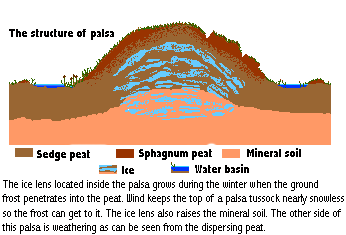Ground frost penetrates deep into the ground and stays well into the spring if frost occurs before snowfall and/or if snowcover remains thin. In winters when there is a lot of snow, the soil frost layer is thin.
Ground frost first melts close to the earth's surface and only later from deeper in the ground.
The soil frost layer is formed when water on the soil freezes.
The freezing and melting of earth is delayed parallel to the situation on earth's surface, because the soil (humous, grain composition, etc.), as well as snow prevent and isolate the effects of frost. Furthermore, the humidity of the soil affects the progression of ground frost.
If snow cover arrives early, and if it is strong, the ground remains unfrozen through the winter because of a heat reserve that is formed over the summer. This often happens especially in the areas in and around Kainuu and Kuusamo. In the western and southwestern parts of Finland there usually isn't a lot of snow, so ground frost penetrates deeper there.
In sandy soil and gravelly till ground frost usually penetrates to the depth of about half a meter. In clay and marshland - and in places where water runs on the ground - there is much less ground frost because of humidity. But in dry marsh tussocks ground frost remains well into the early summer because of the peat insulation. (Compare: permafrost)
In the winter of 1984-85, the depth of ground frost doubled compared to normal, and some was found above the Kristiinankaupunki - Kajaani line as late as June. Even though there is generally not much ground frost in Kuusamo because of the thick snow cover, some has been found there even in July and August, as was the case in the summer of 1987.
According to the latest information permafrost is melting on the northern hemisphere. More: The greenhouse effect
In Finland, permafrost can be found chiefly in the palsa mires in Lapland.

Wind carries snow away from palsa tussocks, and hence there is no insulation effect. Peat, however, is a heat insulator, so ground frost does not have enough time to melt away from the palsa mounds in the summer.